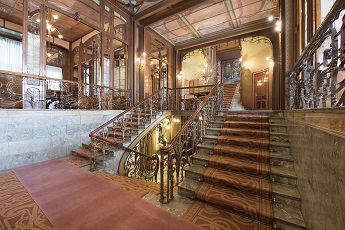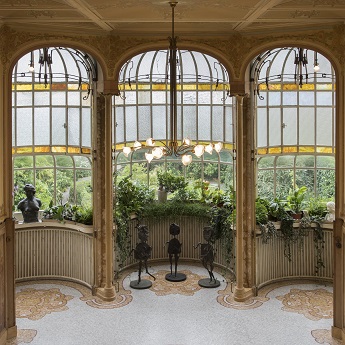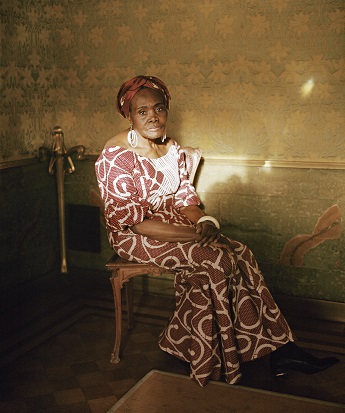In 1893, when world-renowned Belgian architect Victor Horta built Hôtel Tassel on a side street of Avenue Louise, he laid the foundations for a new style – one characterised by ornate façades, floral motifs, sinuous lines and sumptuous interiors with generous application of glass and iron, intimately connected with the decadent atmosphere of the turn of the century.
One hundred and thirty years after its inception, Brussels wants to rediscover Art Nouveau. To reclaim its position as the birthplace of the movement, city officials have declared 2023 the Year of Art Nouveau. Reconnecting with a glorious past, however, means addressing its more disturbing aspects.
Although much has been lost over the years, Belgium’s capital is still home to around 1,000 Art Nouveau buildings, at least 200 of which are protected as historic monuments, according to estimates by city officials. It is with these numbers in mind that the local administration set out to position Brussels as the world capital of Art Nouveau, not-so secretly challenging major competitors and tourism champions such as Barcelona and its architecture by Antonio Gaudí, another leading Art Nouveau figure.
Pascal Smet, the secretary of state for urbanism and heritage for the Brussels-Capital Region, the political administration that represents the city’s 19 municipalities, is the driving force behind the initiative.
“We have an incredible wealth in quality and quantity of Art Nouveau buildings in our city. In my opinion, we were too modest about it,” he tells The Parliament.
 The Hotel Solvay, in Brussels | Photo: Explore Brussels, Sophie Voituron
The Hotel Solvay, in Brussels | Photo: Explore Brussels, Sophie Voituron
“By organising the Year of Art Nouveau, we show that Brussels can rightfully claim the position of global Art Nouveau capital. 2023 is just the start of a very nice long-term story,” he adds.
The city’s administration has cast its net wide to put together an extensive programme. “We provide the frame; then every organisation has the autonomy to develop their content and activities,” explains Alice Grass, the co-ordinator for the Year of Art Nouveau at Brussels-Capital Region’s urban policy department.
Established cultural events are also getting involved. In March, the annual Brussels Art Nouveau Art Deco (Banad) festival threw open the doors to several buildings normally closed to the public, such as Villa Pelseneer in Uccle, Hôtel Pieper in Ixelles and the old “maison-atelier” of sculptor Fernand Dubois in Forest, which today hosts the embassy of Cuba.
As well as shining a light on well-preserved heritage, the initiative’s organisers also hope to revive the memory of buildings that have not survived. The iconic Maison du Peuple, which Horta built in the Sablon area at the request of the Belgian Workers’ Party and which was demolished in 1965, was brought back to life with the help of 3D digital technologies during the Bright Brussels festival of lights in February.
Looking ahead, other regular events taking on an Art Nouveau focus this year include Brussels’ Iris festival in early May, and the heritage days in September. And October sees the opening of an exhibition examining Horta’s singular style at the Bozar Fine Arts centre, considered one of the architect’s masterpieces.
The programme’s focus revolves around a number of iconic buildings. The Hôtel van Eetvelde, added to the Unesco World Heritage List in 2000, is one of them.
It was designed in 1895 by Horta as a residence for Belgian diplomat Edmond van Eetvelde, appointed by King Leopold II as Administrator-General for Foreign Affairs of the Congo Free State. Ten years earlier, the Belgian king had seized control of the African landmass and begun a 23-year rule over the territory as his private possession.
International outrage over the human rights abuses committed under his reign eventually led the Belgian government to take control. Estimates vary, but about half the Congo’s population is believed to have died as a result of the acts of violence and cruelty under Leopold’s rule.
For the interior of the lavish mansion, Horta used wood and ivory extracted from the colony, as well as motifs evoking Africa, including elephants. Today, it houses the information desk for Brussels’ Year of Art Nouveau – presenting the event’s organisers with a major challenge, or some might say opportunity, to confront Belgium’s horrific colonial past.
 The Hotel Max Hallet, another Horta masterpiece in Brussels | Explore Brussels/ Sophie Voituron
The Hotel Max Hallet, another Horta masterpiece in Brussels | Explore Brussels/ Sophie Voituron
The rise of Art Nouveau in Belgium is inextricable from the concurrent exploitation of Congo, its people and its rich natural resources. “Exotic” wood, ivory and other materials, extracted by Congolese people under the brutal whip of colonial forces, are part of what defined the Art Nouveau style as it rose to prominence in Belgium. Indeed, in Belgium, another name for Art Nouveau was “Style Congo”.
At the same time, many of Brussels’ Art Nouveau architectural masterpieces were commissioned by those whose careers and fortunes were built on the profits of exploiting Congo.
The need to reflect critically on the artistic movement of a century ago is stressed throughout much of this year’s celebrations, and some programmes specifically embrace present efforts to decolonise Belgium’s public spaces.
In the heart of Ixelles, the Civa (otherwise known as the International Centre for the City and the Architecture) is a temple for enthusiasts curious about contemporary and modern architecture. Until 3 September this year, it hosts the exhibition Style Congo – Heritage & Heresy.
“We are adding new elements and perceptions to the Art Nouveau history,” says Nikolaus Hirsch, the museum’s artistic director who curated the exhibition together with Congolese artist Sammy Baloji, Civa curator Silvia Franceschini and historian Estelle Lecaille. “Architecture is always embedded in a political, social and economic context.”
Working with the city’s decolonisation taskforce, set up in 2020, and artists and communities of African descent, Style Congo chronicles the often propagandist representation of Congo in international expositions held between 1885 and 1958, using Art Nouveau as its anchor point.
 Leonie Ngoie, who was born in Congo before it gained independence from Belgium, poses in the Hotel van Eetvelde | Chrystel Mukeba
Leonie Ngoie, who was born in Congo before it gained independence from Belgium, poses in the Hotel van Eetvelde | Chrystel Mukeba
The Brussels 1897 International Exhibition, which included a human zoo in which at least 267 Congolese people were put on display to the public, was a key example of this trend. It was organised to attract investors and to garner support from the Belgian public for King Leopold II’s colonial project. The colonial palace built for this exhibition in Tervuren was also constructed in an Art Nouveau style.
“One of our missions is to show historic materials, but through the lens of contemporary artists and architects. At a time of cultural appropriation, we want to mark a symbolic reappropriation of a difficult heritage,” Hirsch explains.
“Heritage is not a given or a homogeneous notion; it does not belong to one single social group. However, the current narrative around Art Nouveau does not consider other histories coming from the margins. That is why heritage must be debated, and why cultural institutions must enable people to participate in the conversation,” he says.
As part of Style Congo, Belgian photographer Chrystel Mukeba, whose father was born in Congo, was commissioned to take a series of portraits of Belgians with Congolese roots. Mukeba was to pose her subjects in iconic Art Nouveau buildings with links to Belgium’s colonial past, such as the Hôtel van Eetvelde.
The difficulties she encountered in persuading the owners and managers of Art Nouveau buildings to give permission for her to take photographs inside as part of the project suggest that not everyone is ready – or interested – in participating in the conversation Style Congo wants to open.
Mukeba tells The Parliament that she contacted the present-day owners of some 10 Art Nouveau buildings in Brussels. Five accepted. The others either never got back to her; others declined, citing renovation works. But she also encountered another obstacle, one that had less to do with practicalities.
“The experiences we had in requesting authorisation [showed that if] it’s to do a fashion shoot or something like that, there’s no issue. But as soon as you start to want to have people of African descent pose [as part of a project with a decolonising theme], then it becomes a lot more complicated,” she explains.
At the same time, she insists her goal with the portraits isn’t to launch a “polemic”. “This is really about asking questions, about simply interrogating oneself.”
Asked what drew her to the project, Mukeba notes that her father moved to Belgium from what is today the Democratic Republic of Congo at a very young age. He completely broke with his country of birth, and as a result, Mukeba says she didn’t grow up with Congolese culture.
“Initially, it started out as a commission, but then it became a project, a personal project,” she says, pointing out that she has always identified as a photographer rather than a Belgian-Congolese photographer. “It was truly through this project that I was able to learn more about [Congo, its culture and its colonial history].”
Sign up to The Parliament's weekly newsletter
Every Friday our editorial team goes behind the headlines to offer insight and analysis on the key stories driving the EU agenda. Subscribe for free here.